Easy Political Map of Iowa With Cedar Falls
Waterloo-Cedar Falls Highway Chronology
In the auto trail era (1910-26), Black Hawk County was on two major routes: The Red Ball Route, running from St. Louis to St. Paul, a forerunner of the Avenue of the Saints; and the Hawkeye Highway, which ran from Dubuque to Sioux City via Waterloo, Fort Dodge, Cherokee, Le Mars, and Sioux City. (It angled northwest, along today's IA 7 corridor, because the route hewed close to the Illinois Central Railroad.) There was a minor trail, the La Crosse-Tama-Kansas City Route, running more directly north and south.
There were three main routes between Waterloo (1910 pop. 26,693) and Cedar Falls (1910 pop. 5012): North of the Cedar River along the Illinois Central, south of the Cedar River near the interurban, and even farther south. Huebinger's 1912 Map and Guide for Hawkeye Highway put the Hawkeye on this southernmost street, a 7-mile rural road named Cedar Falls Avenue. However, later that decade (possibly April 26, 1918, given a date on an old map), more attention was directed to the middle route, Whitney Road. This road was renamed Rainbow Drive on Dec. 2, 1919, to honor the Rainbow Division of World War I.
Rainbow Drive, the first hard-surfaced rural road in Black Hawk County, opened June 10, 1920. The Waterloo Evening Courier reported, "The pavement is of concrete base with a bituminous, filled brick surface - the best that money can buy. The road is 18 feet in width[.]" The road also passed by the two most important facilities of the time. First, there was the newly opened Hippodrome at the National Cattle Congress (today's McElroy Auditorium [update: they're back to calling it the Hippodrome]). Second, the route passed the factory that started as the Waterloo Gasoline Engine Company but, in March 1918, had been purchased by a plow manufacturing company from Moline interested in getting into the newfangled tractor business.
Six weeks after Rainbow Drive opened, Black Hawk County let a contract to paint signs for the new Iowa highway system. The Hawkeye Highway, also known as the Grant Highway since 1916, became IA 5; the Red Ball Route, IA 40; the L.T.K., IA 59; and a road from Cedar Falls past Iowa State Teachers College to Grundy Center, IA 57.
The area covered in this map is approximately that of the current Waterloo-Cedar Falls inset on the state map, plus southward to Hudson. Running from upper left to lower right is the Cedar River. Each year's box lists the street routing for major highways and the junction or end points for certain routes. Underneath that, all the changes that happened between that map and the next. All "Courier" references are to the daily newspaper in Waterloo that has gone by an assortment of names over the years. (Not all articles are listed.) Dates also come from Iowa Highway Commission meetings and Jason Hancock's research.
Known tweaks in the area in 1924 were on the south side of Hudson (IA 59 moved from Hudson Road and Wood Street to the Washington Street diagonal south of the school), northwest of Waterloo (IA 40 moved from Donald Street, Wagner Road, and a portion of present-day Airline Highway to an extension of Cedar Bend Street paralleling the railroad on the south), and southeast of Washburn (IA 40 flipped to stay on the west side of the railroad instead of crossing twice between Washburn and present-day Eagle Road/D46).

IA 5, W-E: 1st Street, Franklin Street, 7th Street, Main Street, 13th Street, Waterloo Road, Rainbow Drive, Whitney Street, Westfield Avenue, McKinley Street, Miles Street, Commercial Street, 5th Street, Independence Avenue
IA 40, S-N: La Porte Road, Commercial Street, 5th Street, Franklin Street, Oak Avenue, Park Road, Broadway Street, Riehl Street, Burton Avenue, Parker Street, Cedar Bend Street, Lincoln Street, Center Street
IA 57, W-E: Unnamed rural road (future University Avenue southwest of town), Hudson Road, 27th Street, Normal Avenue (future College Street), 18th Street, Main Street; end Main at 13th
Fifth Street Bridge: Going northeastward, carries EB 5 and NB 40/59
The Courier got wind in early February 1926 of the new highway numbers coming and printed the Highway Commission's 1925 maps then and in October showing what the new system would look like. But on October 16, 1926, US 20 was signed on the north side of the Cedar River and US 218 on the south side. It meant US 20 replaced IA 5 and US 218 replaced IA 40 except between Cedar Falls and IA 59. Instead, 20 took 40's route and 218 took 5's route. The Highway Commission refused to change this at its meeting December 14, because this version kept traffic for 20 and 218 off the Fifth Street Bridge. City leaders were, to use a phrase not in use at the time, cheesed off. ("City officials indignant over new road route," Courier, Dec. 17)
Incidentally, just off the intersection of East Fifth and Franklin (where the Red Ball and Hawkeye used to meet, but now 20 and 218 would not) was a prominent Willys-Overland car dealership building, which 30 years later would become the base for eastern Iowa's NBC-TV station, KWWL.1929: 20 moved from 5th Street to 6th Street between Franklin and Independence
November 7, 1929 (approved December 11, 1928): 218 changes from Rainbow-Commercial alignment to Falls-Washington alignment. Six blocks of Washington had to be finished in 1930 before completely moving off Commercial. This comes only a decade after Rainbow Drive opened, but the bricks had taken a hard pounding.
September 10, 1931: 57 realigned on new route on south side of Cedar Falls
1931 or first half of 1932: 20 moved from 6th to 7th Street between Franklin and Independence
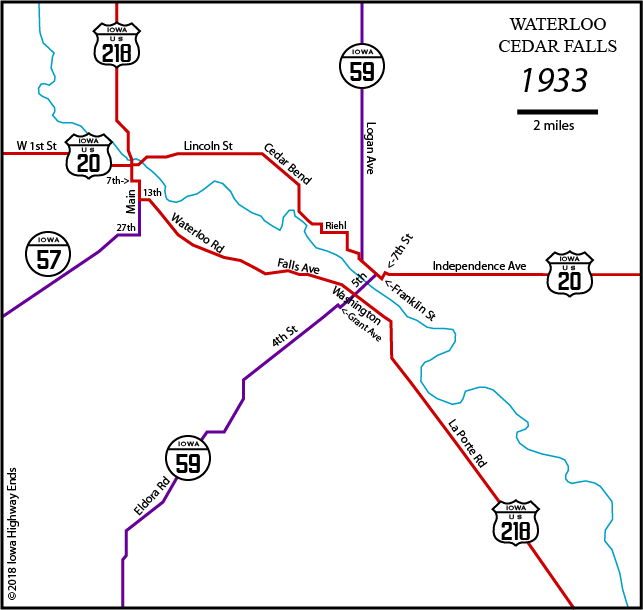
US 20, W-E: W 1st Street, Lincoln Street, Cedar Bend Street, Parker Street, Burton Avenue, Riehl Street, Broadway Street, Park Road, Oak Avenue, Franklin Street, 7th Street, Walnut Street, Independence Avenue
IA 59, S-N: Eldora Road, 4th Street, Grant Avenue, 5th Street, Franklin Street (share w/20), Logan Avenue
US 218, S-N: La Porte Road, Washington Street, Falls Avenue, Waterloo Road, 13th Street, Main Street, 7th Street, Center Street. At the time, Waterloo Road was a rural drive!
Fifth Street Bridge: Both directions of IA 59
Jct. 20/59: Franklin/Logan to Franklin/5th
Jct. 59/218: 5th/Washington
East End 57: Main Street at 13th Street
October 13, 1933: Reroute of 20 along Parker Street and Logan Avenue approved upon completion of paving of Parker Street � but the change never happened. The reason is unknown.
December 1, 1934: US 63 replaces IA 59 ("Primary road No. 59 will become a federal highway," Toledo Chronicle, Dec. 13); signs put up around February 15, 1935
December 18, 1934: 57 extended along 218 and 20 to 59-turning-63 north of Waterloo
April 9, 1935: 58 extended north via County Road C and dirt road to meet 20 ("C.Falls-Hudson Road Put In Iowa Primary System", Courier, March 26). Original 58 junction with 63 (but not its end, since 58 continued to Grundy Center) was 5th at Jefferson in Hudson, with a squared-off corner for the route to the west.
August 8, 1939: IA 297 commissioned between downtown Waterloo and Evansdale on Lafayette Street
April 2, 1940 (approved October 31, 1939): 63 taken off 5th, put on 4th and Park (with a block on Washington); 297's west end moved a block west
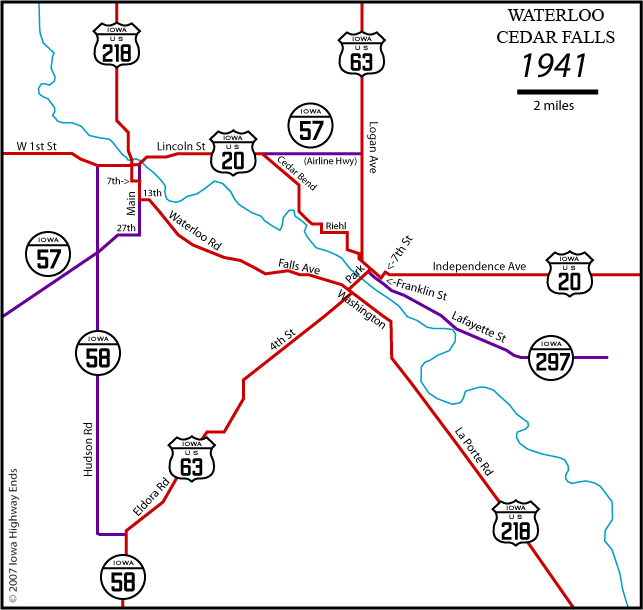
US 20, W-E: W 1st Street, Lincoln Street, Cedar Bend Street, Parker Street, Burton Avenue, Riehl Street, Broadway Street, Park Road, Oak Avenue, Franklin Street, 7th Street, Walnut Street, Independence Avenue
US 63, S-N: Eldora Road, 4th Street, Washington Street, Park Avenue, Franklin Street (share w/20), Logan Avenue
US 218, S-N: La Porte Road, Washington Street, Falls Avenue, Waterloo Road, 13th Street, Main Street, 7th Street, Franklin Street, Center Street
Park Avenue Bridge: Both directions of US 63
Note: Main Street in Cedar Falls north of 7th is IA 57 only
Jct. 20/63: Franklin/Logan to Franklin/5th
Jct. 63/218: Park/Washington (shared 1 block)
East End 57: Lincoln (now Airline Highway in Waterloo) at Logan
North End 58: Hudson Road at W 1st
West End 297: Lafayette at Park
1940s: 218 connector between Main and Franklin in Cedar Falls changes from 7th Street to 4th
ca. 1948: IA 58 in Hudson moved to more angled alignment, now meets 63 on south side
May 30, 1948: 218 between Rainbow Drive/Waterloo Road intersection and Main Street moved onto extension of 18th Street in Cedar Falls ("Cutoff Paving Is Completed", Waterloo Sunday Courier, May 30)
November 22, 1950: Park Avenue bridge becomes 63 northbound, while 5th Street becomes 63 southbound. The reverse one-way system was extended a few blocks southwest to Wellington Avenue in 1951, according to maps, but changed back to Washington in 1958.
July 9, 1952: 218 moved off 18th Street and part of Waterloo Road in Cedar Falls to meet Main Street at 27th ("218 cutoff now open to traffic", Courier, July 9; not on map until 1955)
August 25, 1956: 57 and 58 swap routes north of the (present) University/Hudson intersection, lengthening 57's duplex with 20 and making 58 end at 218, and also giving six blocks of Main to Cedar Falls after 218's east-west jog returned to 6th. (However, the 1959 map shows the connection back on 4th.)
Last week of September 1956: 218 straightened out west of Washington Street, off of Falls Avenue; this is the part that became Headford Avenue
Fall 1956: Four-lane freeway proposed running south from "new Hwy. 20" in Waterloo, initially billed as "relocated US 63" but designated IA 402 on April 2, 1957
July 7, 1957: New road between Jesup and Elk Run Heights opens to local traffic but not signed as 20
Late 1957: 20 "streamlined" along a new Broadway Street route between Lincoln Street and Franklin Street downtown. The Oak-Franklin intersection is blocked off today but Utica Street is available nearby.
Note: 1958 state map and inset show 20 using Lafayette east of downtown to Raymond, while 281 is already extended west along 20's old route. This was a pre-emptive marking, as documentation shows 20 was not to be rerouted until Dubuque Road was finished between Nevada Street and Elk Run Heights.
September 19, 1958: New 20 opens between 63 and Jesup, including four-lane divided highway to Elk Run Heights; 281 extended along Independence Avenue into Waterloo; 297's north end moved to Raymond ("New Hwy. 20 to be open Friday", Courier, Sept. 18)
September 1960: IA 412 commissioned between West 4th Street (63) and La Porte Road (218) ("Bypass Rt. 412 Almost Ready As Cutoff Between 63, 218", Courier, Sept. 13). More than one Highway Commission project used the label "Relocation Hwy. No. 20" before it got a number.
December 7, 1960: New "short cut" christened San Marnan Drive
July 29, 1962: New 63 paralleling railroad south of Waterloo, including new route through Hudson, opens ("By-pass finished; Highway 63 open again to Hudson," Traer Star-Clipper, Aug. 8)
Special mention: The 1961 resurfacing of the soon-to-be-previous alignment of US 63 between Hudson and Waterloo used maps from the 1924 paving of IA 59. Much later, a 2018 document for work on IA 21 in Tama County called back the initial plans for IA 402 four decades earlier. That is some fine record-keeping.
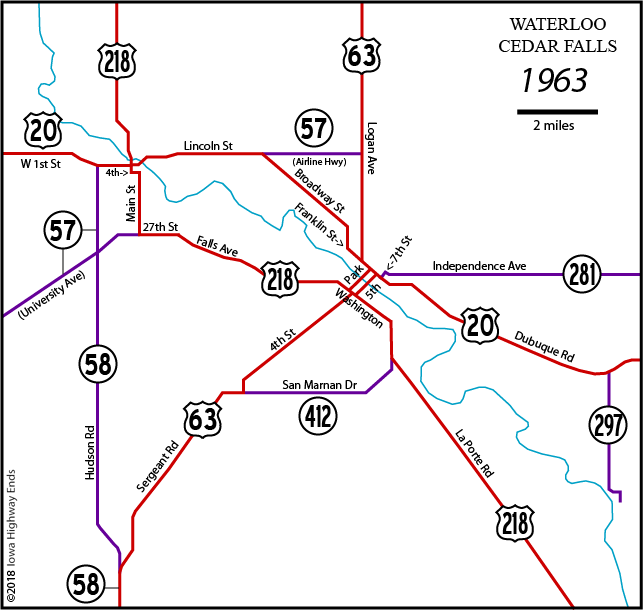
US 20, W-E: W 1st Street, Lincoln Street, Broadway Street, Franklin Street, Dubuque Road
US 63, S-N: Sergeant Road, San Marnan Drive (if name carried), 4th Street, Washington Street (share w/218), Park Avenue (NB)/5th Street (SB), Franklin Street (share w/20), Logan Avenue
US 218, S-N: La Porte Road, Washington Street, Headford Avenue, Falls Avenue, Waterloo Road, 27th Street, Main Street, 4th Street, Franklin Street, Center Street
US 63 across the Cedar River: 2/15/35 to 4/2/40, Fifth Street; 4/2/40 to 11/22/50, Park Avenue; 11/22/50 to 12/16/68, NB Park Avenue, SB Fifth Street; 12/16/68 to 10/9/69, NB Park Avenue, SB Mullan Avenue; 10/9/69 to 2/16/70, NB First Street, SB Mullan Avenue; 2/16/70 to 11/23/70, NB First Street, SB Fifth Street; 11/23/70 to present, NB First Street, SB Mullan Avenue
Jct. 20/63: Franklin/Logan to Franklin/5th
Jct. 63/218: Park/Washington and 5th/Washington, each direction sharing a block
East End 57: Lincoln St/Airline Hwy at Logan
North End 58: 27th (University) at Main
West End 281: Franklin at 63 (w/20)
May 29, 1963: West end of 281 set Seventh at Franklin
October 31, 1963: Mullan Avenue extension for 63 north of Franklin opens, including the railroad underpass that would be replaced with an overpass in 2018-19
October 13, 1967: 218 moves from 4th to 6th in Cedar Falls (doesn't appear on maps until 1970)
December 16, 1968: 63 moves onto new Sergeant Road. It shares about 4 blocks of surface streets with 218. Southbound 63 moves from Fifth Street to Mullan Avenue. The piece of San Marnan Drive between Sergeant and 4th becomes an extension of 412. ("New Route for 63 Opens on Monday", Courier, Dec. 13)
January 1, 1969: 58 truncated to Hudson; not-yet-completed IA 402 becomes an extension of 21
August 11, 1969: 21 opens south to IA 8, as a two-lane road ("Highway 21 Will Open Monday", Courier, Aug. 7)
October 9, 1969: Northbound 63 moved from Park to First
1970: 412 intersection with 218 moved southward from Ridgeway Avenue to current San Marnan/La Porte Road intersection, about concurrent with construction for Crossroads Mall. This flipped the intersection from being north of the brand-new fire station to the south. US 218 was widened in the area at the same time.
February 16-November 23, 1970: Southbound 63 routed back onto Fifth while a new Mullan bridge is built
July 1, 1970: Route of 218 from Main Street in Cedar Falls to 63 renamed University Avenue
1970: University widened to 6 lanes ("University Fix-Up Project Mulled," Courier, April 26, 2006)
1971: 63's Sergeant Road approach to University modified slightly, with 218 upgraded to six lanes between University and Mullan; area between there and John Deere Waterloo Works cleared out
December 18, 1973: 20/57 moved south onto four-lane extension of West 1st Street and new Broadway; short Diagonal Street connecting Airline Highway with new Broadway is nearly an abandoned road today. ("Highway 20 is Broadway", Courier, Dec. 18)
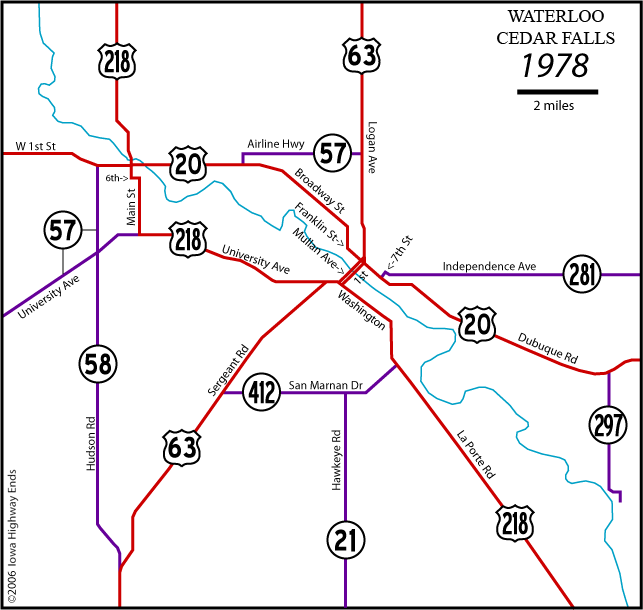
US 20, W-E: W 1st Street, Broadway, Franklin Street, Dubuque Road
US 63: S-N: Sergeant Road, University Avenue, Mullan Avenue (NB)/1st Street (SB), Mullan Avenue, Logan Avenue
US 218, S-N: La Porte Road, Washington Street, University Avenue, Main Street, 6th Street, Franklin Street, Center Street
Jct. 20/63: Franklin/Mullan (NB) and Franklin/1st (SB)
Jct. 63/218: Sergeant/University to Univ-Wash-Mullan intersection (shared a few blocks, NB split where University becomes Washington)
East End 57: Airline Highway at Logan
North End 58: University at Main
West End 281: 7th at Franklin
1978-81: I-380 drawn in as dashed line through Waterloo all the way up to George Wyth State Park; built as US 218 decade later
July 1, 1980: 57 segment along Airline Highway decommissioned, end becomes Hudson at 1st in Cedar Falls
October 1, 1983: 412 turned over to city while westernmost part is torn up to make room for 63/20 interchange
December 1, 1983: 281 truncated to Waterloo city limits
January 1, 1984: 281 sent due south from Dunkerton to 20 instead of along Independence Avenue
August 9, 1984: New freeway for 20 opens between 297 and 21, but 20 itself only moves onto it east of new 218 and I-380. US 218 moves onto new freeway between Mitchell Avenue (with I-380) and Shaulis Road; old route remains La Porte Road west of new freeway but becomes part of Texas Street on the east side.
December 7, 1984: Freeway opens between 63 and 21, still not signed as part of 20
September 12, 1985: Final segment of I-380 opens between Urbana and 20 (off map)
June 14, 1986: New 20 freeway opens between the Grundy County line and 63; 20 and 57 swap routes in Cedar Falls; Dubuque Road (20) and University Avenue/Hudson Road segments (57) turned over to cities and county
July 1, 1987: 58 truncated to interchange with 20

US 20, W-E: Freeway, with I-380 east of 218; interchanges at IA 58, Butterfield Rd, US 63, IA 21, I-380/US 218
US 63: S-N: Sergeant Road, University Avenue, Mullan Avenue (NB)/1st Street (SB), Mullan Avenue, Logan Avenue
US 218, S-N: La Porte Road, freeway segment, I-380, Washington Street, University Avenue, Main Street, 6th Street, Franklin Street, Center Street
Jct. 20/63: Interchange
Jct. 63/218: Sergeant/University to Univ-Wash-Mullan intersection (shared a few blocks, NB split where University becomes Washington)
East End 57: Franklin at Mullan
North End 58: Interchange, slightly east of original Hudson Road
November 15, 1988: 281 brought back to east city limits of Waterloo
October 2, 1989: 218 realigned between 57 intersection and Greenhill Road; 218 uses new freeway, Greenhill, and University while 57 ends at 1st Street intersection with Center/Franklin in Cedar Falls. Rest of 57 east of airport, which was old 20, turned over to city. Note: 218 between IA 58 and the airport exit is four lanes in both directions.
November 21, 1991: New six-lane expressway for 218 opens between 63 and Mitchell Avenue, with stoplights; northbound 218 open on elevated section in downtown
November 12, 1992: Final part of new 218 in Waterloo opens, with new interchanges at Ansborough/Fletcher avenues and 63, completely taking it off University. Traffic going from 63 to southbound 218 must use a surface road that parallels the elevated expressway.
December 31, 1992: University Avenue officially turned over
November 19, 1993: New four-lane extension of 58 opens between 20 and University Avenue with stoplights at Ridgeway Avenue, Viking Road, and Greenhill Road. ("Sign of the times", Courier, Nov. 19) In the next decade this road and these intersections would become points of contention, development, and quite a few deaths.
July 21, 1995: Final part of new 58 between University Avenue and new 218/57 interchange opens; 218 moves onto new four-lane from that interchange northward; 57 extended along 1st Street to new interchange
Late 1990s: Exit numbers added on US 20 freeway

US 20, W-E: Freeway, with I-380 east of 218; interchanges at IA 58 S, IA 58 N, US 63, IA 21, I-380/US 218
US 63: S-N: Sergeant Road, "frontage" roads at US 218 interchange, Mullan Avenue (NB)/1st Street (SB), Mullan Avenue, Logan Avenue
US 218, N-S: Freeway/expressway; interchanges at US 20, San Marnan Drive, Washington Street (later labeled "Downtown"), US 63, Fletcher/Ansborough Avenues, Greenhill Road, Broadway Street, IA 57/58
Jct. 20/63: Interchange
Jct. 63/218: Interchange spanning area from University/Sergeant intersection to Mullan
East End 57: Interchange with IA 58 and US 218
North End 58: Interchange with IA 57 and US 218
March 11, 1998: DOT takes much of University Avenue back with little fanfare, creating secret IA 934
September 2001: IA 27 added along 218, 58, and 20
July 1, 2003: IA 297 decommissioned
2004: IA 27 mile markers replace 58's mile markers along four-lane route
2005: IA 57 five-laned (four with turning lane) west of Hudson Road
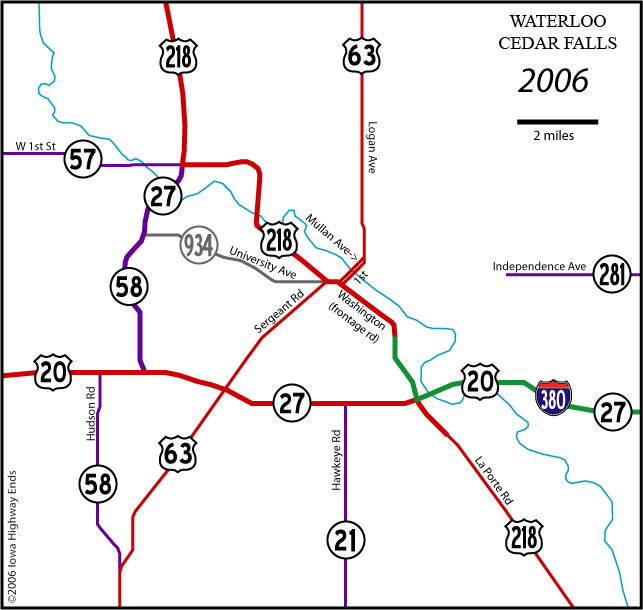
November 9, 2006: Ansborough Avenue exit opens on US 20
2013: IA 58's south end rebuilt in Hudson
July 21, 2014: Cedar Falls portion of 934 turned over
August 9, 2016: Waterloo portion of 934 turned over, ending all state control of University Avenue
November 1, 2019: IA 27/58 Viking Road interchange opens
Also November 1, 2019: US 63 reconstruction north of downtown Waterloo completed, including changing railroad underpass from 1963 into overpass
2021: Exit numbers added to IA 27/58, with 27's numbers
What if?
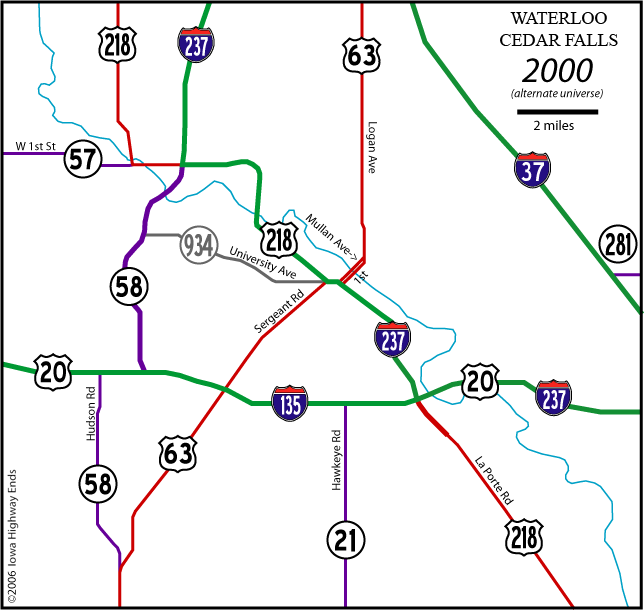
This map shows what might have happened if the Avenue of the Saints had been included in the original interstate system and followed US 63 north of Waterloo instead of US 218, and also if a four-lane US 20 had been part of, say, the 1968 addition to the Interstate Highway System. I believe that many of the four-lane roads built in the 1980s and 1990s would still exist, in the Waterloo area, but in slightly modified forms.
Page created 2/18/05; last updated 10/13/21
To Iowa Highway Ends Annex
To Iowa Highway Ends Index
harrisonspere1953.blogspot.com
Source: https://iowahighwayends.net/maps/waterloo.html
Post a Comment for "Easy Political Map of Iowa With Cedar Falls"